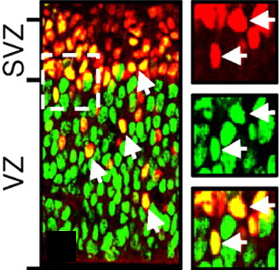Wrap your brain around precursor cells
Posted by Erin M Campbell, on 10 February 2012
 A fully differentiated cell took a fascinating journey to become its present self. For every cell, a precursor cell existed that gave rise to it. And for every precursor cell, a stem cell existed that gave rise to it. Understanding precursor cells is an important part in understanding stem cell biology. Today’s image is from a recent paper in Development that discusses how neuron precursor cell divisions affect development of the cerebral cortex.
A fully differentiated cell took a fascinating journey to become its present self. For every cell, a precursor cell existed that gave rise to it. And for every precursor cell, a stem cell existed that gave rise to it. Understanding precursor cells is an important part in understanding stem cell biology. Today’s image is from a recent paper in Development that discusses how neuron precursor cell divisions affect development of the cerebral cortex.
The cerebral cortex is the outermost layer or brain tissue, and is commonly referred to as “gray matter.” During development, the different regions and layers of the cerebral cortex are formed from precursor cells. These intermediate precursor cells (IPCs) arise from radial glial cells (RGCs), which come from neural stem cells. The different layers of the cortex are formed from radial migration of the postmitotic neurons produced by RGCs and IPCs. The length of time each RGC or IPC cell resides in the cell cycle regulates the distance its daughter neuron can migrate—cells that exit the cell cycle earlier are able to migrate further, while neurons that are born later cannot migrate as far. Exploring this connection between the cell cycle and formation of cortex layers, Mairet-Coello and colleagues recently published results showing how two different cyclin-dependent kinase inhibitors (CKIs) regulate different stages of precursor proliferation and affects development of the different layers. Specifically, p57KIP2 regulates the cell cycle length of RGCs and IPCs, which in turn affects neurogenesis of layers 5 and 6. p27KIP1, however, regulates the proliferation of IPCs, in turn affecting neurogenesis exclusively in layers 2-5. In the images above, p57KIP2(red) is found in actively dividing precursor cells (PCNA, green) in two different proliferative zones in the developing mouse brain, labeled SV and SVZ. The SV contains proliferating RGCs and IPCs, while the SVZ mostly contains proliferating IPCs. Arrows point to p57KIP2-postitive proliferating cells.
For a more general description of this image, see my imaging blog within EuroStemCell, the European stem cell portal.
Mairet-Coello, G., Tury, A., Van Buskirk, E., Robinson, K., Genestine, M., & DiCicco-Bloom, E. (2012). p57KIP2 regulates radial glia and intermediate precursor cell cycle dynamics and lower layer neurogenesis in developing cerebral cortex Development, 139 (3), 475-487 DOI: 10.1242/dev.067314


 (1 votes)
(1 votes)